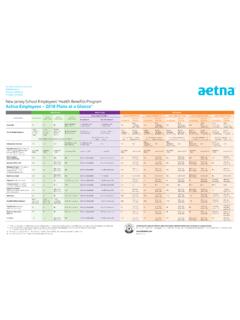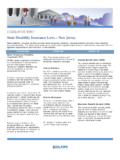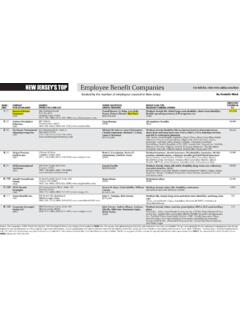Transcription of The Economic Benefits of the New Jersey
1 The Economic Benefits of the New Jersey Stem Cell Research Initiative Joseph J. Seneca University Professor Will Irving Research Associate Edward J. Bloustein School of Planning and Public Policy Rutgers, The State University of New Jersey Prepared for Office of the Governor Trenton, New Jersey September 2005 Table of Contents Executive Summary i Introduction 1 Economic Impact of Public Expenditures 2 Savings in Health Care Costs 9 Work Time and Productivity Savings 18 Value of Premature Deaths Avoided 21 Retention and Expansion of the Biotechnology Industry 32 Royalty Payments to New Jersey
2 40 Summary and Conclusions 42 Appendix 47 Bibliography 51 Additional Data Sources 54 Acknowledgements The authors thank Professor Michael Lahr of the Center for Urban Policy Research at the Edward J. Bloustein School at Rutgers University for careful assistance with the Economic impact estimates, Professor Jeffrey Rubin of the Department of Economics at Rutgers University for thorough and insightful comments on an earlier draft, Sara Filipek of Analysis Group for generous assistance with methodology and cost estimates, and Dr. Philip Furmanski, Executive Vice President for Academic Affairs, Rutgers University for discussions of research grant leveraging.
3 They also thank Dr. Sherrie Preische, Executive Director of the New Jersey Commission on Science and Technology and Mark Matzen, Deputy Chief of Staff, Governor s Office, for advice, comments, and discussions during the project. i Executive Summary This report estimates the potential Economic Benefits to New Jersey of the proposed stem cell research initiative. New Jersey has a long history of innovation and discovery leading to sustained and profound improvements in the quality of life and accompanying threshold increases in income, jobs, and Economic activity. The proposed stem cell initiative is consistent with this legacy and offers the state the opportunity to be a full participant in the collaborative worldwide research effort that has such promise to alleviate the pain and suffering of so many. We estimate the potential Economic Benefits of the initiative for six areas. Benefits Directly Attributable to the Initiative.
4 We estimate that the Economic Benefits to New Jersey that can be attributed directly to the initiative - - the Economic impact of expenditures, the retention and expansion of the biotechnology industry, and the royalty payments from intellectual property - - are $ billion in new Economic activity, close to 20,000 new jobs, and $ million in new state revenues (taxes and royalties) over the time period 2006 to 2025. (See p. 43 and Table 19, p. 46). Economic Impact of Public Expenditures. From 2006 to 2008, the $150 million in proposed capital and equipment expenditures will create over 1,450 jobs, generate $ million in additional Economic activity, and increase state tax revenues by $ million and local tax revenues by $ million. (See pp. 4-6). In addition, from 2006 to 2013, the $230 million in proposed research spending will create almost 2,600 jobs, generate $ million in Economic activity, and increase state tax revenues by $ million and local tax revenues by $ million.
5 (See pp. 7-8). Retention and Expansion of Biotechnology and Pharmaceutical Industries. There is a large and vibrant iibiotechnology industry in New Jersey that is subject to intense global competition. Public policies that create a supportive environment for stem cell research, including state of the art research capacity and the attraction of excellent scientists and students at Rutgers and UMDNJ and other New Jersey higher education institutions, will be an important factor in retaining and expanding this industry. Using conservative assumptions about the amount of private leveraging of public investment, we estimate that close to 16,000 additional jobs will be created, and Economic activity in the state will expand by over $1 billion in the 2006 to 2025 period. This additional activity will also generate $ million in additional state tax revenues and $ million in new local tax revenues. (See pp. 32-40). Royalty Payments to New Jersey . New intellectual property that potentially can be generated from the state s investment in stem cell research is estimated to result in $ million in royalty income for New Jersey in the period 2016 to 2023.
6 This estimate is based on a conservative assumption about the total investment costs historically required for a successful commercial therapy. (See pp. 40-42). Broader Benefits to New Jersey . A broader aggregation of potential stem cell therapy Benefits to New Jersey consisting of reductions in health care costs, savings in work time lost, and decreases in premature deaths will occur independent of the location of the research that develops those therapies. Over the period 2016 through 2025, such Benefits total close to $73 billion, using conservative assumptions about the efficacy of the therapies. State fiscal gains from both types of Benefits - - those directly attributable to the initiative and those that accrue to New Jersey regardless of where the research is done - - are estimated to be $ billion. (See p. 43-45 and Table 20, p. 46). iii Savings in Health Care Costs. We analyze six health conditions (diabetes, Parkinson s Disease, spinal cord injury, heart attack, stroke, and Alzheimer s Disease) that are likely to benefit from stem cell therapies.
7 An estimated 363,000 New Jerseyans currently suffer from these conditions. We estimate that health care costs in New Jersey will be reduced by $ billion over the ten year period from 2016 to 2025 as a result of the implementation of effective stem cell therapies. This total includes a $ billion savings to the state budget. (See pp. 9-18). Work Time and Economic Productivity Savings. We estimate that, in the absence of improved treatments, over million workdays in New Jersey will be lost because of these six health conditions from 2016 to 2025. Using conservative assumptions about the effectiveness of stem cell therapies, we estimate that there will be a savings of $813 million to the New Jersey economy from reductions in work days lost. (See pp. 18-21). Value of Premature Deaths Avoided. The core goal of stem cell research is to alleviate the human suffering and pain associated with disease and injuries. Accordingly, a central benefit of the research will be the reduction in premature deaths as a result of new therapies.
8 We estimate that, in the absence of new treatments, close to 75,000 New Jerseyans will die prematurely (losing a total of 818,000 life-years) from the six health conditions during the period 2016-2025. Again, using conservative assumptions about the effectiveness of potential stem cell therapies, as well as for the value of a life-year saved, we estimate Benefits of over $ billion in New Jersey due to reductions in premature deaths. (See pp. 21-30). iv Caveats. While we have consistently used conservative assumptions throughout the report, it is important to note several caveats. First, there is uncertainty about whether the ultimate results of stem cell research will yield effective therapies. At the same time, however, the therapies we assume here may only be a part of what, in fact, will be the ultimate portfolio of effective stem cell treatment protocols. That is, many other debilitating, painful, and costly health conditions, beyond the six analyzed here, may benefit from stem cell research.
9 Second, it is important to understand that we do not attribute all the Benefits estimated in the report to New Jersey s investment in stem cell research. Specifically, the Benefits from premature deaths avoided, the Benefits of the reduction in work days lost due to illness, and the health care cost savings all would occur following the discovery and widespread implementation of effective stem cell therapies from research done anywhere in the country or the world. Rather, our estimates of these Benefits are intended to demonstrate, using conservative assumptions, the very large magnitude and scale of what is at stake for New Jersey in terms of the potential Benefits of stem cell research. 1 Introduction This report provides a preliminary analysis of the potential Economic Benefits of New Jersey s proposed stem cell initiative. There is enormous promise in stem cell research to improve the quality of human life as a result of the possible reduction in the costly effects of a number of particularly devastating diseases - - stroke, heart attack, diabetes, Parkinson s Disease, spinal cord injury, and Alzheimer s Disease.
10 However, the potential for unanticipated breakthroughs in many other areas of human health is unlimited and any estimates of the impact of stem cell research on future health conditions must be regarded as educated projections subject to wide variation and uncertainty. Basic research, without specific initial purpose, has often been the source of powerful and ubiquitous impacts on society. Such research has, at times, resulted in the development of vast new industries and accompanying threshold increases in income, employment, and Economic activity with profound improvements in the quality of life. Antibiotics, the laser, the computer chip, and the Internet are examples of the often-unpredictable outcomes that have emerged from basic research. Basic research has led to major innovations that have transformed how we live and how well we live in unexpected and comprehensive ways. The six areas of Economic Benefits of New Jersey s stem cell initiative identified in this report are: the direct Economic impact of significant state expenditures on buildings, equipment and research grants; the potential reduction in overall health care costs and in New Jersey State budget health care costs associated with new stem cell therapies; the savings in work time and Economic productivity now lost due to health conditions that potentially can be ameliorated by stem cell therapies, the public good Benefits of reductions in premature deaths; the attraction, retention and expansion of the 2biotechnology and pharmaceutical industries in New Jersey , and the royalty payments to the state as an investing partner in stem cell research.









